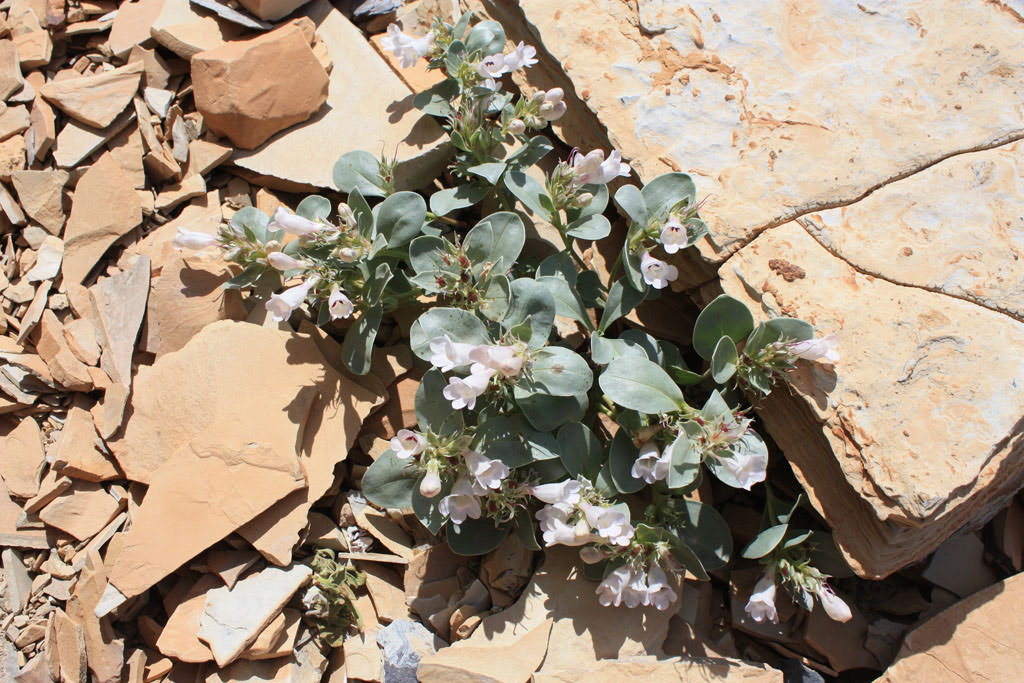Scientific Name : Penstemon debilis
Author : O'Kane & J. Anderson![]() NatureServe Explorer
NatureServe Explorer
Common Name : Parachute Penstemon
![]() Current Research Activities
Current Research Activities
![]() 1997 profile
1997 profile
Click link below for details.
Taxonomy
Plantaginaceae (plantain family)
Ackerfield (2015, 2022) places this genus in the Plantaginaceae family.
Ranks and Status
State Rank : S1
State Rank Reason : Penstemon debilis is endemic to Garfield County, Colorado, USA. This species is restricted the Mahogany Zone of the Parachute Creek Member of the Green River Formation found on the Roan Plateau within the Piceance Basin. Threats to the species include habitat loss and fragmentation associated with energy development, road maintenance, potential competition from invasive plant species and long term drought resulting from climate change.
U.S. Endangered Species Act : ESA Threatened
Colorado Threatened and Endangered List : none
Other Statuses : SWAP Tier 1
Description and Phenology
General Description:
Penstemon debilis is a member of the figwort family (Schrophulariaceae). It is an herbaceous perennial which often forms mats or trails where the stems may root at the node. The flowers are white to lavender. There are no basal leaves and the cauline leaves are sessile, opposite, succulent and blue-glaucous (O'Kane and Anderson 1987).
Look Alikes:
Easily distinguished from other Penstemon species by its weak stems, succulent, glabrous, and glaucous leaves, and its white to pale lavender corollas (Spackman et al. 1997).
Phenology:
Flowers from mid June to mid July. Fruits mid July-August (Colorado Natural Heritage Program 2012).
 |
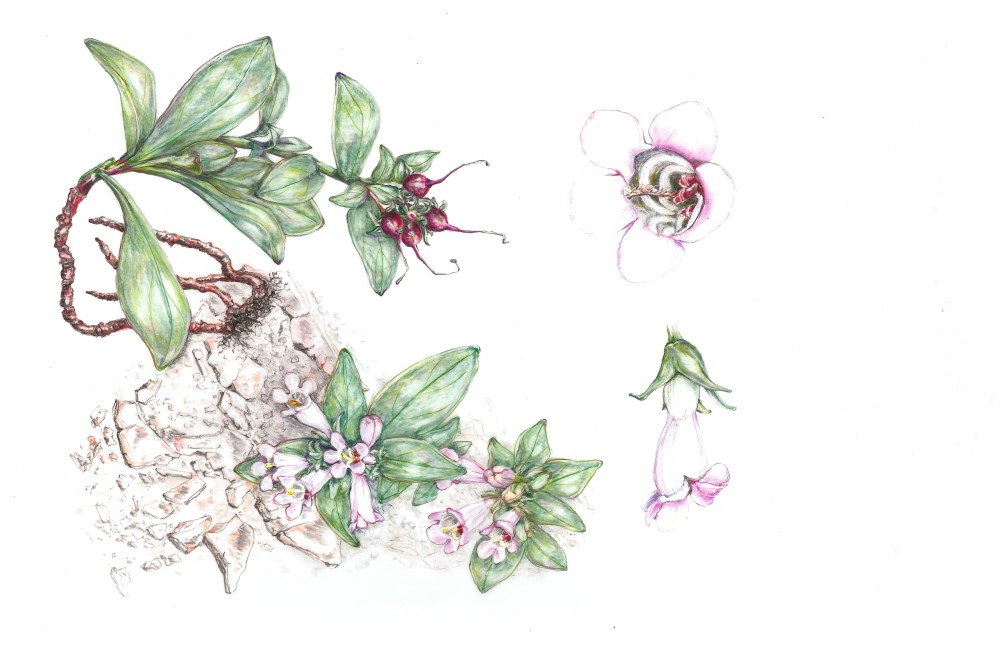 |
Habitat
Sparsely vegetated, south-facing, steep, white shale talus of the Parachute Creek Member of the Green River Formation. Soils are a mixture of thin shale fragments and clay (Spackman et al. 1997). Associated species include: Agropyron spicatum, Cercocarpus montanus, Chrysothamnus viscidiflorus, Cymopterus hendersonii, Eriogonum lonchophyllum, Galium coloradoense, Holodiscus dumosus, Machaeranthera grindeliodes, Monardella odoratissima, Astragalus lutosus, Festuca dasyclada, and Thalictrum heliophilum (O'Kane and Anderson 1987).
click on image to enlarge
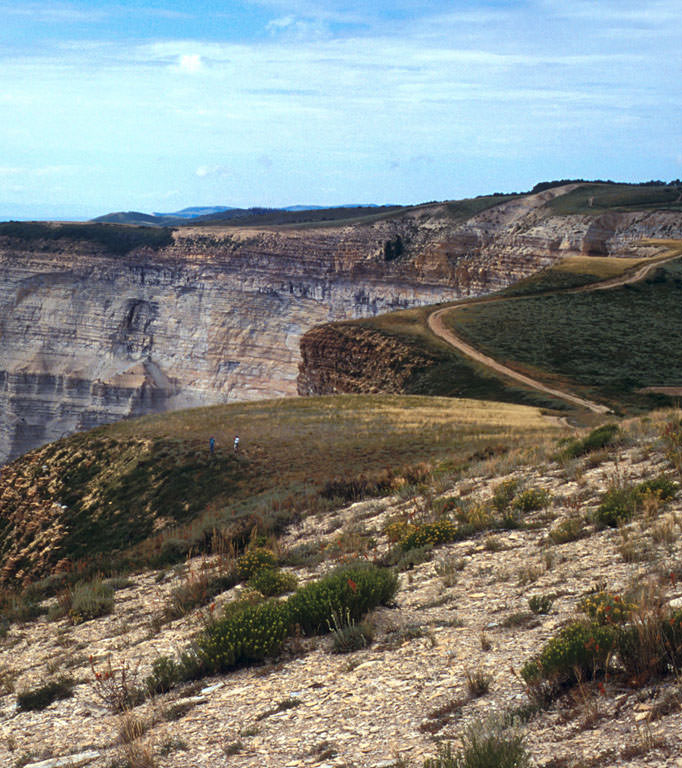 | 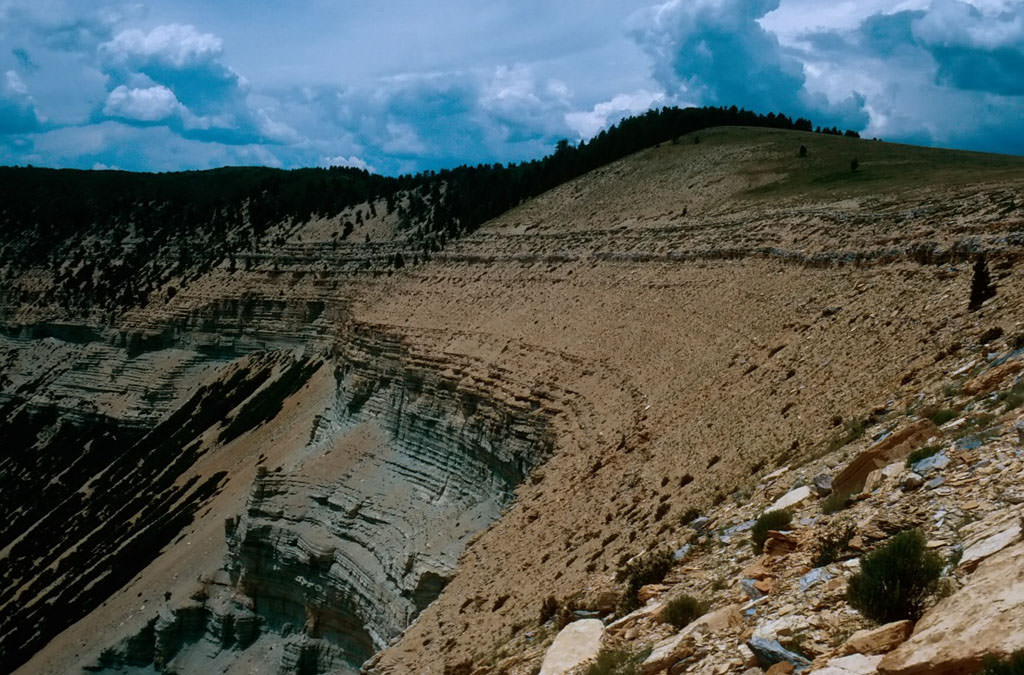 |
Elevation Range:
5,338 - 8,568 feet (1,627 - 2,611 meters)
Distribution
Colorado Endemic:
Yes
Range:
Penstemon debilis is endemic to Garfield County, Colorado, USA. This species is restricted the Mahogany Zone of the Parachute Creek Member of the Green River Formation found on the Roan Plateau within the Piceance Basin. The estimated range extent in Colorado of 114 square kilometers was calculated in GeoCAT using occurrence data provided by the Colorado Natural Heritage Program (2022).
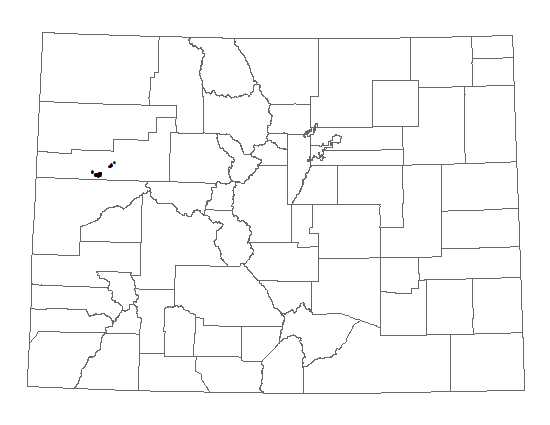 Click on map to enlarge |
Threats and Management Issues
Threats to the species include the loss and fragmentation of habitats associated with energy development, road maintenance, potential competition from invasive plant species and long term drought (USFWS 2022). Although some mine access roads within occupied habitat have been closed, there remain portions of occurrences that have recently been found along gravel roads and continue to be threatened by road maintenance. Non-native invasive plant species have been observed at several sites and may outcompete P. debilis. Long term drought in the region continues to be a concern, and P. debilis declines have been observed in years of lower than average moisture (Handwerk et al. 2022, USFWS 2020). Both drought and habitat shifting and alteration due to climate change are listed as threats in Appendix A of the Colorado State Wildlife Action Plan (Handwerk et al. 2015).
 Summary results of an analysis of the status of Penstemon debilis based on several ranking factors. This species was concluded to be under conserved. From Rondeau et al. 2011. |
References
- Ackerfield, J. 2012. The Flora of Colorado. Colorado State University Herbarium. 433 pp.
- Ackerfield, J. 2015. Flora of Colorado. BRIT Press, Botanical Research Institute of Texas, Fort Worth, TX. 818 pp.
- Ackerfield, J. 2022. Flora of Colorado. Second Edition. Bot. Misc. 60. BRIT Press, Fort Worth Botanic Garden/Botanical Research Institute of Texas, U.S.A. 861 pp.
- Colorado Natural Heritage Program (CNHP). 2022. Biodiversity Tracking and Conservation System (Biotics 5). Colorado Natural Heritage Program, Colorado State University, Fort Collins.
- Elliott, B. A., S. Spackman Panjabi, B. Kurzel, B. Neely, R. Rondeau, M. Ewing. 2009. Recommended Best Management Practices for Plants of Concern. Practices developed to reduce the impacts of oil and gas development activities to plants of concern. Unpublished report prepared by the Rare Plant Conservation Initiative for the National Fish and Wildlife Foundation.
- Handwerk, J., L. Grunau, and S. Panjabi. 2015. Colorado Wildlife Action Plan: 2015 Rare Plant Addendum. Colorado Natural Heritage Program, Colorado State University, Fort Collins, Colorado, USA.
- Handwerk, J.E., D.G. Malone, N.C. Swayze and J.P. Smith. 2022. Monitoring Colorado’s SWAP Tier 1 plant species Penstemon debilis, 2021. Colorado Natural Heritage Program, Colorado State University, Fort Collins, Colorado.
- Irelend, T. 2002. Candidate and listing priority assignment form: Penstemon debilis. U.S. Fish and Wildlife Service, Grand Junction, Colorado.
- McMullen, A.L. 1998. Factors concerning the conservation of a rare shale endemic plant: the reproductive biology and edaphic characteristics of Penstemon debilis (Scrophulariaceae). Master's thesis, Utah State University, Logan, Utah.
- Murray, D.K., and J.D. Haun. 1974. Introduction to the geology of the Peceance Creek Basin and vicinity, Northwestern Colorado. Pages 29-39 in D.K. Murray, editor. Energy resources of the Piceance Creek Basin, Colorado, Twenty-fifth field conference. Rocky Mountain Association of Geologists, Denver, Colorado.
- Neely, B., S. Panjabi, E. Lane, P. Lewis, C. Dawson, A. Kratz, B. Kurzel, T. Hogan, J. Handwerk, S. Krishnan, J. Neale, and N. Ripley. 2009. Colorado Rare Plant Conservation Strategy, Developed by the Colorado Rare Plant conservation Initiative. The Nature Conservancy, Boulder, Colorado, 117 pp.
- O'Kane, S. L. and J. H. Broderick. 2004. Petition to list Parachute Penstemon (Penstemon debilis) as threateed or endangered, prepare and emergency listing rule, and designate critical habitat under the Endangered Species Act (16 U. S. C. 1531, ET SEQ.) . Center for Native Ecosystems, Denver, CO and Colorado Native Plant Society. Ft. Collins, CO.
- O'Kane, S.L., Jr., and J.L. Anderson. 1987. Penstemon debilis (Scrophulariaceae): a new species from Colorado endemic to oil shale. Brittonia 39: 412-416.
- Rocky Mountain Society of Botanical Artists. 2009. RARE Imperiled Plants of Colorado, a traveling art exhibition. Exhibition catalogue developed by the Denver Botanic Gardens and Steamboat Art Museum.
- Rondeau, R., K. Decker, J. Handwerk, J. Siemers, L. Grunau, and C. Pague. 2011. The state of Colorado's biodiversity 2011. Prepared for The Nature Conservancy. Colorado Natural Heritage Program, Colorado State University, Fort Collins, Colorado.
- Rondeau, R.J., M.B. Wunder, A. Meredith, C.A. Pague, and S. Spackman. 1996. Biological survey of Naval Oil Shale Reserve No. 1 (NOSR-1). Unpublished report for the Department of Energy, Casper, Wyoming by the Colorado Natural Heritage Program, Fort Collins, Colorado.
- Spackman, S., B. Jennings, J. Coles, C. Dawson, M. Minton, A. Kratz, and C. Spurrier. 1997. Colorado rare plant field guide. Prepared for Bureau of Land Management, U.S. Forest Service and U.S. Fish and Wildlife Service by Colorado Natural Heritage Program.
- Spackman, S., K. Fayette, K. Carsey, and R. Rondeau. 1997. Field survey and protection recommendations for the globally imperiled parachute Penstemon, PENSTEMON DEBILIS. Unpublished report for the Colorado Natural Areas Program, Denver, Colorado by the Colorado Natural Heritage Program, Fort Collins, Colorado.
- U.S. Fish and Wildlife Service (USFWS). 1996. Endangered and threatened wildlife and plants; review of plant and animal taxa that are candidates for listing as endangered or threatened species. Federal Register 61(40):7596-7613.
- U.S. Fish and Wildlife Service (USFWS). 2005. Endangered and threatened wildlife and plants; reivew of native species that are canddates or proposed for listing as endangered or threatened; annual notice of findings on resubmitted petitions; annual description of progress on listing actions; proposed rule. Federal Register 70(90):24883.
- U.S. Fish and Wildlife Service (USFWS). 2020. Species Status Assessment for Parachute beardtongue (Penstemon debilis). Western Colorado Ecological Services Field Office. Grand Junction, Colorado. Online https://ecos.fws.gov/ecp/species/7099#ssa (Accessed 2022).
- U.S. Fish and Wildlife Service (USFWS). 2022. U.S. Fish and Wildlife Service. 2022. Recovery plan for Parachute Beardtongue (Penstemon debilis). August 2022. U.S. Fish and Wildlife Service, Mountain-Prairie Region, Denver, Colorado. 21 pages. Online: https://ecos.fws.gov/docs/recovery_plan/20220817_FinalRecoveryPlan_ParachuteBeardtongue_v5_Signed.pdf (Accessed 2022).
- USDA, NRCS. 2022. The PLANTS Database. National Plant Data Team, Greensboro, NC 27401-4901 USA.
- Weber, W. A. and R. C. Wittmann. 2012. Colorado Flora, Western Slope, A Field Guide to the Vascular Plants, Fourth Edition. Boulder, Colorado. 532 pp.



